torque PONTIAC GRAND PRIX 2002 Owners Manual
[x] Cancel search | Manufacturer: PONTIAC, Model Year: 2002, Model line: GRAND PRIX, Model: PONTIAC GRAND PRIX 2002Pages: 374, PDF Size: 2.63 MB
Page 106 of 374
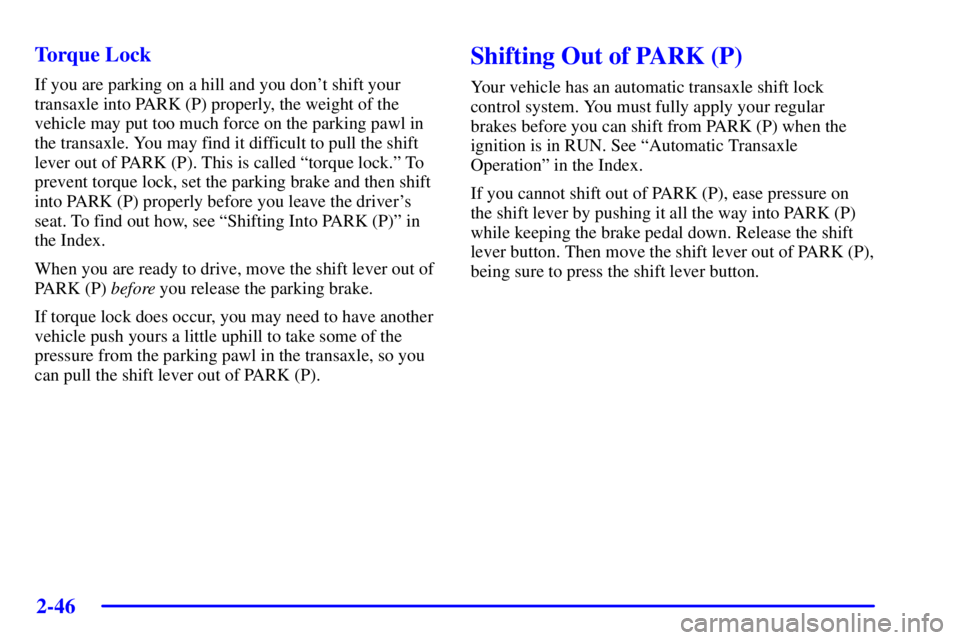
2-46
Torque Lock
If you are parking on a hill and you don't shift your
transaxle into PARK (P) properly, the weight of the
vehicle may put too much force on the parking pawl in
the transaxle. You may find it difficult to pull the shift
lever out of PARK (P). This is called ªtorque lock.º To
prevent torque lock, set the parking brake and then shift
into PARK (P) properly before you leave the driver's
seat. To find out how, see ªShifting Into PARK (P)º in
the Index.
When you are ready to drive, move the shift lever out of
PARK (P) before you release the parking brake.
If torque lock does occur, you may need to have another
vehicle push yours a little uphill to take some of the
pressure from the parking pawl in the transaxle, so you
can pull the shift lever out of PARK (P).
Shifting Out of PARK (P)
Your vehicle has an automatic transaxle shift lock
control system. You must fully apply your regular
brakes before you can shift from PARK (P) when the
ignition is in RUN. See ªAutomatic Transaxle
Operationº in the Index.
If you cannot shift out of PARK (P), ease pressure on
the shift lever by pushing it all the way into PARK (P)
while keeping the brake pedal down. Release the shift
lever button. Then move the shift lever out of PARK (P),
being sure to press the shift lever button.
Page 258 of 374
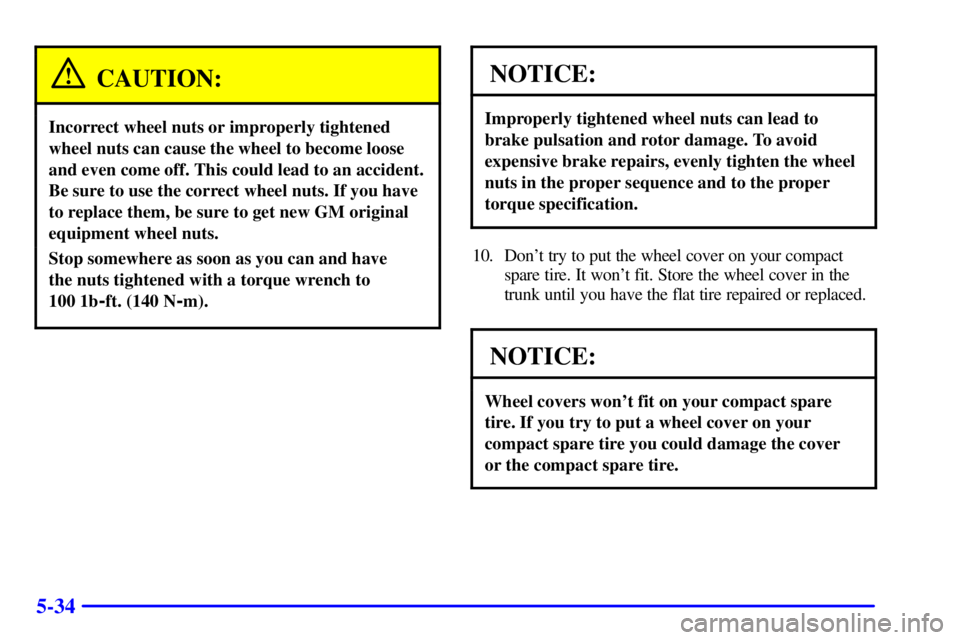
5-34
CAUTION:
Incorrect wheel nuts or improperly tightened
wheel nuts can cause the wheel to become loose
and even come off. This could lead to an accident.
Be sure to use the correct wheel nuts. If you have
to replace them, be sure to get new GM original
equipment wheel nuts.
Stop somewhere as soon as you can and have
the nuts tightened with a torque wrench to
100 1b
-ft. (140 N-m).
NOTICE:
Improperly tightened wheel nuts can lead to
brake pulsation and rotor damage. To avoid
expensive brake repairs, evenly tighten the wheel
nuts in the proper sequence and to the proper
torque specification.
10. Don't try to put the wheel cover on your compact
spare tire. It won't fit. Store the wheel cover in the
trunk until you have the flat tire repaired or replaced.
NOTICE:
Wheel covers won't fit on your compact spare
tire. If you try to put a wheel cover on your
compact spare tire you could damage the cover
or the compact spare tire.
Page 299 of 374
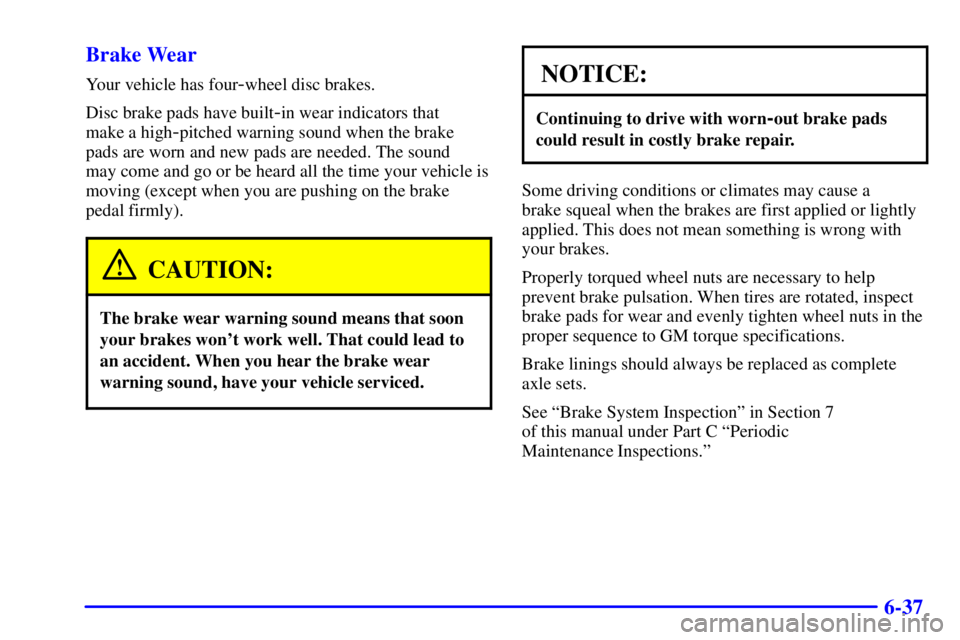
6-37 Brake Wear
Your vehicle has four-wheel disc brakes.
Disc brake pads have built
-in wear indicators that
make a high
-pitched warning sound when the brake
pads are worn and new pads are needed. The sound
may come and go or be heard all the time your vehicle is
moving (except when you are pushing on the brake
pedal firmly).
CAUTION:
The brake wear warning sound means that soon
your brakes won't work well. That could lead to
an accident. When you hear the brake wear
warning sound, have your vehicle serviced.
NOTICE:
Continuing to drive with worn-out brake pads
could result in costly brake repair.
Some driving conditions or climates may cause a
brake squeal when the brakes are first applied or lightly
applied. This does not mean something is wrong with
your brakes.
Properly torqued wheel nuts are necessary to help
prevent brake pulsation. When tires are rotated, inspect
brake pads for wear and evenly tighten wheel nuts in the
proper sequence to GM torque specifications.
Brake linings should always be replaced as complete
axle sets.
See ªBrake System Inspectionº in Section 7
of this manual under Part C ªPeriodic
Maintenance Inspections.º
Page 313 of 374
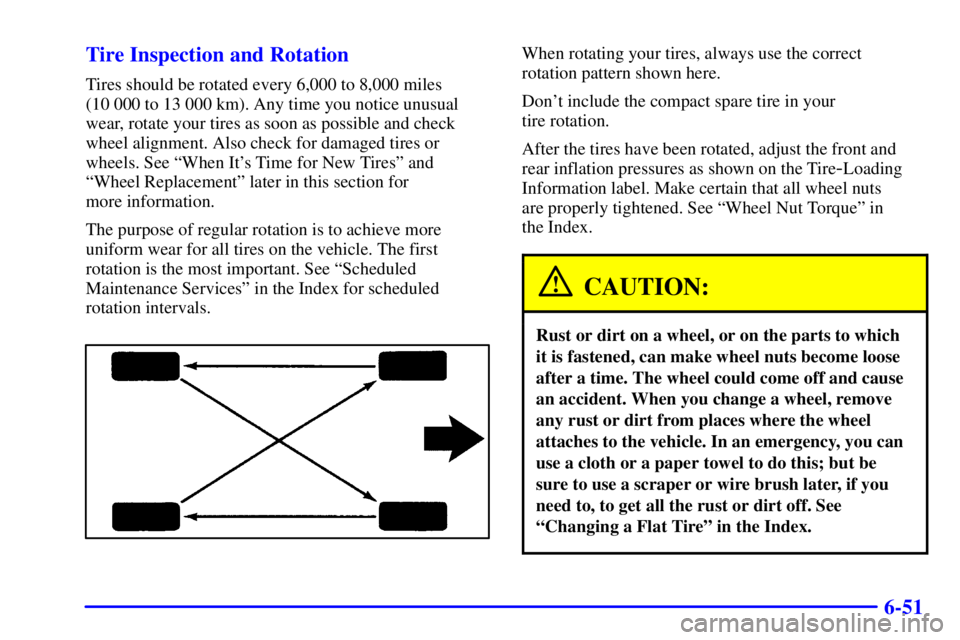
6-51 Tire Inspection and Rotation
Tires should be rotated every 6,000 to 8,000 miles
(10 000 to 13 000 km). Any time you notice unusual
wear, rotate your tires as soon as possible and check
wheel alignment. Also check for damaged tires or
wheels. See ªWhen It's Time for New Tiresº and
ªWheel Replacementº later in this section for
more information.
The purpose of regular rotation is to achieve more
uniform wear for all tires on the vehicle. The first
rotation is the most important. See ªScheduled
Maintenance Servicesº in the Index for scheduled
rotation intervals.
When rotating your tires, always use the correct
rotation pattern shown here.
Don't include the compact spare tire in your
tire rotation.
After the tires have been rotated, adjust the front and
rear inflation pressures as shown on the Tire
-Loading
Information label. Make certain that all wheel nuts
are properly tightened. See ªWheel Nut Torqueº in
the Index.
CAUTION:
Rust or dirt on a wheel, or on the parts to which
it is fastened, can make wheel nuts become loose
after a time. The wheel could come off and cause
an accident. When you change a wheel, remove
any rust or dirt from places where the wheel
attaches to the vehicle. In an emergency, you can
use a cloth or a paper towel to do this; but be
sure to use a scraper or wire brush later, if you
need to, to get all the rust or dirt off. See
ªChanging a Flat Tireº in the Index.
Page 335 of 374

6-73
Fuse Description
6 Cooling Fan 1
7 Battery Main 1
8 Ignition Main 2
18 Fuel Injections
19 Spare
20 Spare
21 Mass Air Flow (MAF),
Heated Sensors, Canister Purge,
Boost Solenoid
22 Spare
23 Spare
24 Spare
25 Ignition Module
26 Spare
27 Trunk Release, Back
-Up Lamps
28 AC Clutch, ABS Ignition Fuse Description
29 Remote Keyless Entry,
Theft
-Deterrent, Trip Computer,
HVAC Module, Security LED
30 Alt Sense
31 Torque Converter Clutch (TCC)
32 Fuel Pump
33 Electronic Control
Module/Powertrain
Control Module
34 Spare
35 Fog Lamps
36 Horn
37 Chime/Mall Module, Taillamps,
Parking Lamps, Sidemarker
Lamps, Dimmable Lamps
38 Spare Fuse
39 Air Pump
40 Mini Fuse Puller
Page 336 of 374
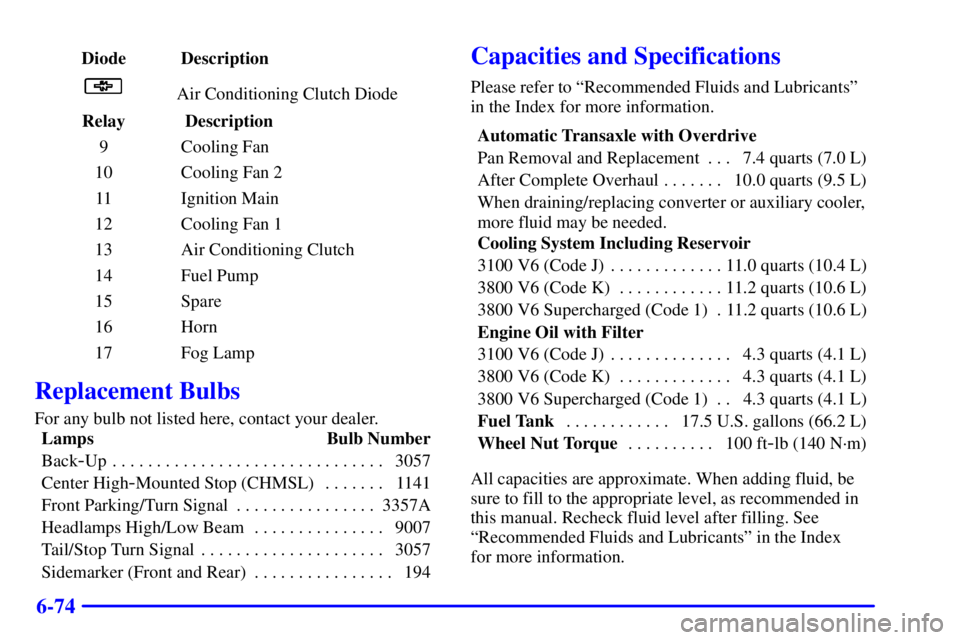
6-74
Diode Description
Air Conditioning Clutch Diode
Relay Description
9 Cooling Fan
10 Cooling Fan 2
11 Ignition Main
12 Cooling Fan 1
13 Air Conditioning Clutch
14 Fuel Pump
15 Spare
16 Horn
17 Fog Lamp
Replacement Bulbs
For any bulb not listed here, contact your dealer.
Lamps Bulb Number
Back
-Up 3057. . . . . . . . . . . . . . . . . . . . . . . . . . . . . . .
Center High
-Mounted Stop (CHMSL) 1141. . . . . . .
Front Parking/Turn Signal 3357A. . . . . . . . . . . . . . . .
Headlamps High/Low Beam 9007. . . . . . . . . . . . . . .
Tail/Stop Turn Signal 3057. . . . . . . . . . . . . . . . . . . . .
Sidemarker (Front and Rear) 194. . . . . . . . . . . . . . . .
Capacities and Specifications
Please refer to ªRecommended Fluids and Lubricantsº
in the Index for more information.
Automatic Transaxle with Overdrive
Pan Removal and Replacement 7.4 quarts (7.0 L). . .
After Complete Overhaul 10.0 quarts (9.5 L). . . . . . .
When draining/replacing converter or auxiliary cooler,
more fluid may be needed.
Cooling System Including Reservoir
3100 V6 (Code J) 11.0 quarts (10.4 L). . . . . . . . . . . . .
3800 V6 (Code K) 11.2 quarts (10.6 L). . . . . . . . . . . .
3800 V6 Supercharged (Code 1) 11.2 quarts (10.6 L).
Engine Oil with Filter
3100 V6 (Code J) 4.3 quarts (4.1 L). . . . . . . . . . . . . .
3800 V6 (Code K) 4.3 quarts (4.1 L). . . . . . . . . . . . .
3800 V6 Supercharged (Code 1) 4.3 quarts (4.1 L). .
Fuel Tank17.5 U.S. gallons (66.2 L) . . . . . . . . . . . .
Wheel Nut Torque100 ft
-lb (140 N´m) . . . . . . . . . .
All capacities are approximate. When adding fluid, be
sure to fill to the appropriate level, as recommended in
this manual. Recheck fluid level after filling. See
ªRecommended Fluids and Lubricantsº in the Index
for more information.